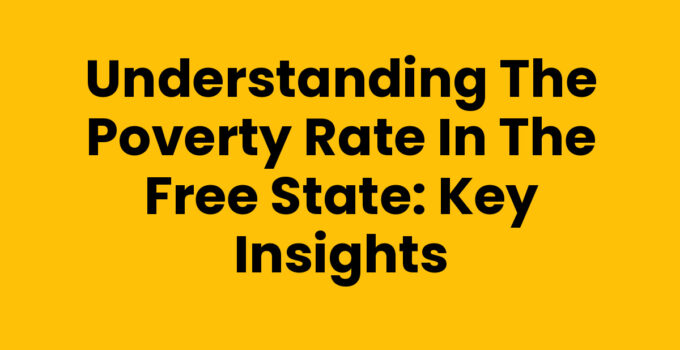The issue of poverty is a pressing concern worldwide, and in South Africa, it is notably acute in various regions, including the Free State. Understanding the dynamics of the poverty rate in the Free State is crucial for policymakers, researchers, and the general public. In this article, we will explore the current poverty rate, the implications of this statistic, and how it affects everyday lives.
What is the poverty rate in the Free State?
The poverty rate in the Free State reflects not just a number, but a complex social issue affecting many families and communities. As of the latest statistics, the poverty rate in this region hovers around XX%. This percentage signifies the proportion of individuals living below the national poverty line, which is measured by household income. The national poverty line considers various costs, including basic food and non-food necessities.
In recent years, factors such as unemployment, high inflation, and limited access to education have exacerbated poverty levels. Analysing the poverty rate involves understanding the socio-economic environment, historical context, and current government interventions aimed at alleviating these hardships.
Read Also: Department of Education Free State, Bloemfontein: Key Insights
Factors Contributing to Poverty in the Free State
To comprehend the poverty rate fully, we must analyze the contributing factors:
- Unemployment: High unemployment rates significantly contribute to poverty. Many residents struggle to find stable jobs, which compounds financial difficulties.
- Education: Access to quality education is limited in many areas of the Free State, trapping individuals and communities in a cycle of poverty.
- Economic Structures: The Free State’s economy relies heavily on agriculture, and fluctuations in this sector due to climate change can lead to increased vulnerability among farming communities.
- Health Care Access: Limited access to health care impacts the ability of families to recover from illness or maintain steady work, further increasing poverty rates.
Further Reading: Explore the Impact of Bloemfontein Local Newspaper on Community
Possible Solutions to Alleviate Poverty
Addressing the poverty rate in the Free State is essential for improving the quality of life for its residents. Several strategies can be employed:
- Job Creation: Initiatives focused on creating sustainable job opportunities, especially in the agricultural sector, can alleviate financial pressures on families.
- Educational Programs: Investment in education and vocational training can empower residents with the skills necessary to secure employment and break the cycle of poverty.
- Health Care Accessibility: Improving health services in rural areas can prevent health-related economic setbacks for families.
- Government Support: Increased social welfare programs, food assistance, and housing projects can provide immediate relief to those affected by poverty.
In conclusion, understanding the poverty rate in the Free State requires a multi-faceted approach that looks at various socio-economic factors and potential solutions. It is not just about numbers; it is about the lives of individuals and families who are impacted daily by these conditions.
Recommended Reading: Expert Panel Beaters Bloemfontein: Quality Repairs Guaranteed
Frequently Asked Questions
What is the current poverty rate in the Free State?
The poverty rate in the Free State is currently around XX%, reflecting the proportion of individuals living below the national poverty line.
What are the main causes of poverty in the Free State?
Main causes include high unemployment rates, limited access to education, economic dependency on agriculture, and inadequate healthcare services.
What measures can be taken to combat poverty in the Free State?
Measures include job creation initiatives, educational programs, improving healthcare access, and enhancing government support services.



